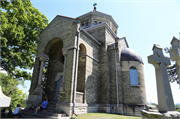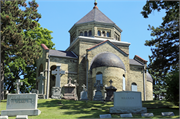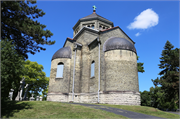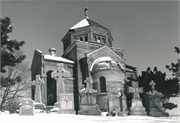Property Record
5503 W BLUEMOUND RD
Architecture and History Inventory
| Historic Name: | Calvary Cemetery Chapel |
|---|---|
| Other Name: | |
| Contributing: | |
| Reference Number: | 53168 |
| Location (Address): | 5503 W BLUEMOUND RD |
|---|---|
| County: | Milwaukee |
| City: | Milwaukee |
| Township/Village: | |
| Unincorporated Community: | |
| Town: | |
| Range: | |
| Direction: | |
| Section: | |
| Quarter Section: | |
| Quarter/Quarter Section: |
| Year Built: | 1899 |
|---|---|
| Additions: | |
| Survey Date: | 1977 |
| Historic Use: | church |
| Architectural Style: | Romanesque Revival |
| Structural System: | |
| Wall Material: | Cream Brick |
| Architect: | ERHARD BRIELMAIER AND SONS |
| Other Buildings On Site: | Y |
| Demolished?: | No |
| Demolished Date: |
| National/State Register Listing Name: | Not listed |
|---|---|
| National Register Listing Date: | |
| State Register Listing Date: |
| Additional Information: | A 'site file' exists for this property. It contains additional information such as correspondence, newspaper clippings, or historical information. It is a public record and may be viewed in person at the State Historical Society, Division of Historic Preservation. OLDEST REMAINING CATHOLIC CEMETERY IN THE CITY. THREATENED WITH DEMOLITION. A castle-like, wooden Gothic Revival gatehouse, built in 1897, marks the entrance to Milwaukee's oldest remaining Roman Catholic cemetery. Stepped gables, crenelated parapets, and denticulated cornices give the building a sense of upright angularity. But a subtler curvilinear motif softens the structure, in the parapets and Palladian window, and culminating in the gatehouse's round-arched entranceway. Inside, are seventy-five acres of park-like rolling hills and mature trees, planned according to the romantic ideals of nineteenth-century landscape design. Like nearby Forest Hills Cemetery, it served as a popular picnic spot before the establishment of city parks in the 1890s. The stone monuments scattered throughout comprise one of the state's best collections of nineteenth-century funerary art. Many of Milwaukee's early civic leaders are buried here, their tombs often marked by handsome monuments, such as the pyramidal mausoleum for druggist Lawrence McMahon and his wife. An exquisite brick Romanesque Revival chapel tops "Jesuit Hill," a grassy knoll rising a hundred feet above the surrounding terrain. Crypts beneath the chapel were reserved for important Roman Catholic clergy, but only one burial ever took place there. Instead, local Catholic clergy were interred on the hillsides around the chapel, giving Jesuit Hill its name. The chapel's dignified octagonal tower is the cemetery’s focal point. Both the gatehouse and chapel were designed by Erhard Brielmaier, who designed St. Josaphat’s Basilica and whose firm designed more than eight hundred churches nationwide between 1880 and 1920. (The following information, including any bibliographic entries [see above], was taken directly from the Determination of Eligibility for Calvary Cemetery, prepared in 2013 by Mead & Hunt, Madison.) The Romanesque-style chapel, completed in 1899, replaced the large wooden cross that originally sat at the top of Chapel Hill. Designed by Erhard Brielmaier & Sons, the completion of the interior of the chapel went slowly, so the chapel was not opened and consecrated until 1902. The chapel has a cruciform plan, rests on a square base of raised limestone, and is constructed of Cream City brick. Three smaller domes on the east, north, and south support a large, eight-sided dome at the center of the building. The main (west) entrance is covered by a large arched brick pediment supported by two limestone columns. The original door has been replaced by wood and a vinyl replacement to prevent vandalism. A large rose window is centered above the door. At the rear (north) of the building there was a large door for bringing in caskets, but is has since been enclosed by concrete block. The original glass from the windows and doors has been removed or broken due to the abandonment of the chapel sometime in the 1950s, as well as vandalism. Side windows have been blocked by wood. It is reported that the original windows were clear and not stained glass. The original interior was reported to be quite plain with no other decorations on the walls. There are two side alters, and a raised alter at the center. All three areas have the original carved wood alters intact. The raised alter also retains its original, wrought iron gate with a flour motif. Below, 27 vaults were built for the burial of Catholic clergy, but only one was ever used, for Father Aegidius Tarasiewicz. |
|---|---|
| Bibliographic References: | MILWAUKEE JOURNAL 7/18/1992. MILWAUKEE JOURNAL SENTINEL SECTION E 11/6/1996. Zimmermann, The Past in Our Present, v. 2, pp. 35-37. Buildings of Wisconsin manuscript. Zimmerman, H. Russell. “Noticed by Many, Known by Few.” The Milwaukee Journal, 30 April 1872. Richter, Tom. Interview by Mead & Hunt, Inc., Milwaukee, Wis. 22 September 2013. Friends of Calvary Cemetery. “A History of Calvary Cemetery and Chapel.” Available in the Calvary Cemetery File, Milwaukee Preservation Commission, Milwaukee, WI. Chasco, Randal S. “Self-Guided Tour of Historic Calvary Cemetery.” Milwaukee, WI: Archdiocese of Milwaukee, 2004. (This publication can also be found on-line at http://www.cemeteries.org/Catholic-Cemeteries/PDF1/CalvarySelfGuidedTour_Final.pdf.) |
| Wisconsin Architecture and History Inventory, State Historic Preservation Office, Wisconsin Historical Society, Madison, Wisconsin |





